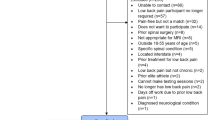Abstract
A multivariate predictive model of low back pain (LBP) was developed. Following a semi-structured interview, 73 participants were assigned to dysfunctional chronic low back pain (DCLBP), functional chronic low back pain (FCLBP), acute low back pain (ALBP), and healthy control (HC) groups. All participants underwent a comprehensive physical, psychophysiological, and psychological evaluation. Multivariate analyses indicated no psychophysiological, few physical, and many psychological differences among the groups. The DCLBP group was found to be most impaired in flexion (p<.001), and the HC group performed the most total work (ft-lb) in extension (p<.001). Psychologically, the DCLBP group displayed greater levels of emotional distress and characterological disturbances and were more functionally impaired (p<.001). Few differences between FCLBP and HC were found. A classification analysis using physical and psychological variables correctly classified 83.3% of DCLBP patients, and it was found that the ALBP group was heterogeneous with some patients having a dysfunctional profile and other patients having a functional profile. The psychological variables were more potent predictors of group membership than were the physical variables. These findings indicate that potential DCLBP and FCLBP patients can be identified shortly following an injury, suggesting important implications for assessment and treatment of low back pain in general, and more specifically, for reducing health care costs and human suffering.
Similar content being viewed by others
References
Andersson G, Epidemiologic aspects of low-back pain in industry.Spine 1981; 6: 53–60.
Roland MO. The natural history of back pain.Practitioner 1983; 227: 1119–1122.
Bonica JJ. Pain research and therapy: Past and current status and future needs. In Ng LKY, Bonica JJ, eds.Pain discomfort, and humanitarian care. Amsterdam: Elsevier, 1980, pp. 1–46.
Frymoyer JW, Pope MH, Clements JH, et al. Risk factors in low-back pain: An epidemiologic survey.J Bone Joint Surg 1983; [Am] 65-A: 213–218.
Follick MJ, Aberger EW, Ahern DK, McCartney J. The chronic low-back pain syndrome: Identification and management.Rhode Is Med J 1984; 67: 219–224.
Frymoyer JW, Cats-Baril W. Predictors of low-back pain disability.Clin Orthop 1987; 221: 89–98.
Waddell GA. New clinical model for the treatment of low-back pain.Spine 1987; 12: 632–644.
Reesor KA, Craig KD. Medically incongruent chronic back pain: Physical limitations, suffering and ineffective coping.Pain 1988; 32: 34–45.
Turk DC, Rudy TE. Toward an empirically derived taxonomy of chronic pain patients: Integration of psychological assessment data.J Consult Clin Psych 1988; 56: 233–238.
Davies GJ.A compendium of isokinetics in clinical usage (3rd. Ed.). Onalaska, Wisconsin: S&S Publishers, 1987.
Mayer TG, Gatchel RJ.Functional restoration for spinal disorders: The sports medicine approach. Philadelphia: Lea & Febiger, 1988.
Dolce JJ, Raczynski JM. Neuromuscular and electromyography in painful backs: Psychological and biomechanical models in assessment and treatment.Psych Bull 1985; 97: 502–520.
Flor H, Turk DC. Psychophysiology of chronic pain: Do chronic pain patients exhibit symptom specific psychophysiological responses?Psych Bull 1989; 105: 215–259.
Ciolino CP, Rosse RB. Controlling chronic pain—An integrated approach.Hosp Phys 1984; 22: 25–32.
Murphy KA, Cornish RD. The syndromes of low-back disease.Arch Phys Med Rehab 1984; 65: 334–337.
Preston JA.ERIC computability. Clifton, New Jersey: Author, 1986.
Stens Corporation,Manual for J & J enterprises. Oakland, California: Author, 1986.
Graham JR.The MMPI: A practical guide (2nd Ed.). New York: Oxford University Press, 1987.
Armentrout DR, Moore JE, Parker JL, Hewett J, Feltz C. Pain-patient MMPI subgroups: The psychological dimensions of pain.J Behav Med 1982; 5: 201–211.
Bradley LA, Van der Heide LH. Pain related correlates of MMPI profile subgroups among back pain patients.Health Psych 1984; 3: 157–174.
McCreary C. Empirically derived MMPI profile clusters and characteristics of low-back pain patients.J. Consult Clin Psych 1985; 53: 558–560.
Bergner M, Bobbitt RA, Carter WB, Gilson BS. The sickness impact profile: Development and final revision of health status measure.Med Care 1981; 19: 785–805.
Bergner M, Bobbitt RA, Pollard WE, Martin DP, Gilson BS. The sickness impact profile: Validation of a health status measure.Med Care 1976; 14: 57–67.
Pollard WE, Bobbitt RA, Bergner M, Martin DP, Gilson BS. The sickness impact profile: Reliability of a health status measure.Med Care 1976; 14: 146–155.
Follick MJ, Smith TW, Ahern DK. The sickness impact profile: A global measure of disability in chronic low-back pain.Pain 1985; 21: 67–76.
Lefebvre MF. Cognitive distortion and cognitive errors in depressed psychiatric and low-back pain patients.J. Consult Clin Psych 1981; 49: 517–525.
Smith TW, Follick MJ, Ahern DK, Adams AE. Cognitive distortion and disability in chronic low-back.Cog Ther Res 1986; 10: 201–210.
Rosenstiel AK, Keefe FJ. The use of coping strategies in chronic low-back pain patients in relationship to patient characteristics and current adjustment.Pain 1985; 17: 33–44.
Turner JA, Clancy S. Strategies for coping with chronic low-back pain: Relationship to pain and disability.Pain 1986; 24: 355–364.
Wallston KA, Wallston BS, DeVellis R. Development of the multidimensional health locus of control (MHLC) scales.Health Ed Mono 1978; 6: 160–170.
Melzack R. The McGill pain questionnaire: Major properties and scoring methods.Pain 1975; 1: 277–299.
Reading A. An analysis of the language of pain in chronic and acute patient groups.Pain 1982; 13: 185–192.
Wilkinson L.SYSTAT: The system for statistics. Evanston, Illinois: Systat, 1986.
Frymoyer JW, Rosen JC, Clements J, Pope MH. Psychologic factors in low-back pain disability.Clin Orthop 1985; 195: 178–184.
Pope MH, Bevins T, Wilder DG, Frymoyer J. The relationship between anthropometric, postural, muscular, and mobility characteristics of males ages 18–55.Spine 1985; 10: 644–648.
Fordyce WE. Pain and suffering: A reappraisal.Am Psych 1988; 43: 276–283.
Bigos SJ, Battie MC, Spengler DM, et al. A prospective study of work perceptions and psychosocial factors affecting the report of back pain.Spine 1991; 16: 688–693.
Gallagher RM, Rauh V, Haugh LD, et al. Determinants of return-to-work among low back pain patients.Pain 1989; 39: 55–67.
McGill C. Industrial back problems: A control problem.J Occup Med 1968; 10: 174–178.
Frymoyer JW. Back pain and sciatica.N Engl J Med 1988; 318: 291–300.
Author information
Authors and Affiliations
Rights and permissions
About this article
Cite this article
Iezzi, A., Adams, H.E., Stokes, G.S. et al. An identification of low back pain groups using biobehavioral variables. J Occup Rehab 2, 19–33 (1992). https://doi.org/10.1007/BF01078929
Issue Date:
DOI: https://doi.org/10.1007/BF01078929




